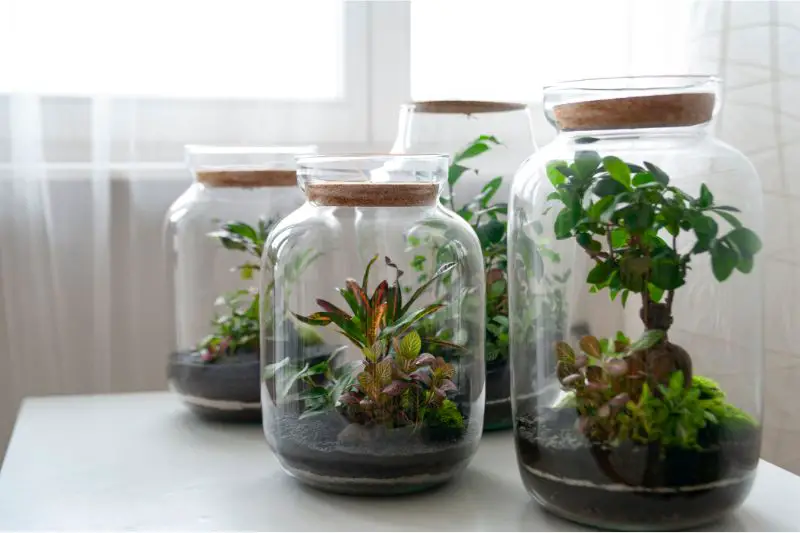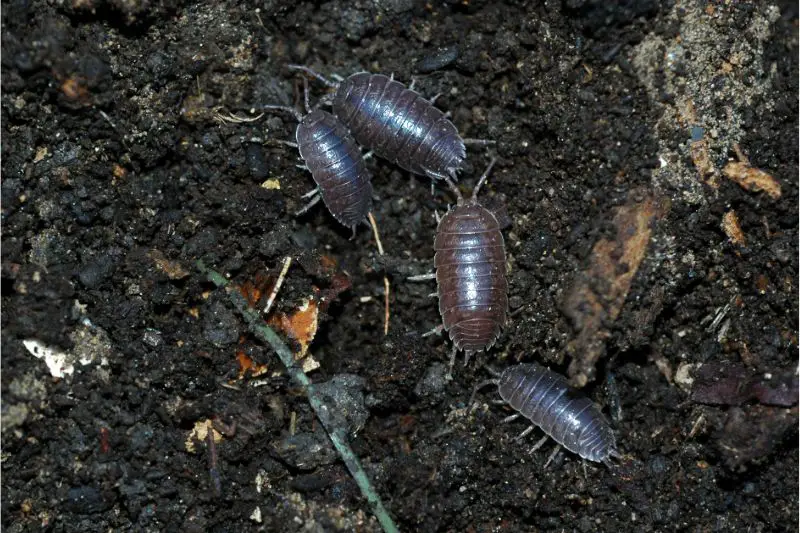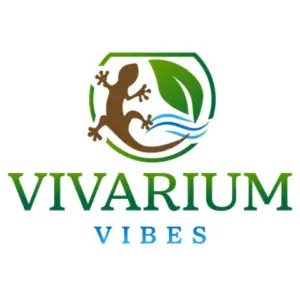This page may contain affiliate links that allow us to make a small commission from qualifying purchases (at no extra cost to yourself). We appreciate your support.
For those who love watching plants grow or who have an interest in ecology, creating and enjoying a terrarium ecosystem can be a rewarding, fun hobby. But what, exactly, is a terrarium ecosystem, and what do you need to start one?
A terrarium ecosystem is a sealed tank, jar, or other vessels in which plants are grown in a self-sustaining manner. Terrarium ecosystems feature soil, plant life, and moisture and may include other living things such as insects or arthropods.
Keep reading to learn more about a terrarium ecosystems, what makes these environments unique, and how you can begin enjoying a terrarium ecosystem today!
What Does a Terrarium Ecosystem Consist Of?
Picture this: a miniature garden enclosed in a glass or plastic container, where the soil, plant life, and moisture coexist in a self-sustaining environment.
This, my friend, is the magic of a terrarium ecosystem! It’s like having your own little world, where the plants and soil work together to create a mini Eco-system.
So, how does it all work?
Well, the soil and plant life release moisture, which then collects on the inside of the container as condensation. And just like that, it rains down on the soil, nourishing and hydrating the plants. It’s like having your own little water cycle right in front of your eyes.
Pretty cool, huh?
Here are a couple of popular plant options to get you started. I have included links to some great options which can be found on Amazon by clicking on each one below.
Popular plant life for terrariums include:
- Moss
- Small Plants (Ferns, Baby tears, Haworthia etc.)
- Succulents
To create your terrarium ecosystem, you will need a see-through jar or tank with a solid lid, soil of the appropriate moisture level and composition, plant life suited for your soil, and a bit of initially added moisture to help keep the terrarium hydrated and growing.
Do Terrarium Ecosystems Need to Be Watered?
Now, here’s the thing: a terrarium ecosystem is a low-maintenance plant haven that doesn’t require frequent watering like your usual houseplant. (Read more about terrarium maintenance in this complete guide here)
Thanks to the magic of evaporation and condensation, the moisture is recycled within the system. However, it’s essential to keep an eye on the water levels, as some water will inevitably be lost as the plants grow and absorb it.
But don’t worry, figuring out how much water your terrarium needs isn’t rocket science!
It all depends on the plants you’ve chosen and how well your terrarium is retaining moisture.
For moisture-loving plants like moss and ferns, a light mist or watering once a month should do the trick. While hardy plants like succulents can go for 4-5 months without a single drop of water.
The best way to know if your terrarium needs water is to check the condensation levels on the sides of the ecosystem. Little to no condensation means that your terrarium could use a light drink. Checking soil moisture levels with your finger is also a simple way to gauge dampness.
Now, let’s talk about sunlight – the life source of plants.
Do Terrariums Need Sunlight?
Most terrarium ecosystems need 4 – 6 hours of indirect sunlight per day. It’s like a balanced diet for plants, too much or too little can throw them off the wagon.
If you’re looking for a more in-depth guide check out this article dedicated solely to a terrarium’s sun-lighting needs. If not, keep reading below for the cliff-notes version…
You don’t want your terrarium to be a sunbathing hotspot either – it’s not Miami beach!
The enclosed environment can get pretty warm, and your plant babies might feel like they’re in a sauna.
Make sure you give your plants the sunlight they deserve, but don’t overdo it! It’s like giving your dog too many treats – it might feel good at the time, but it’s not good for them in the long run.

Different plants have different preferences when it comes to light and heat. Mosses and ferns like it cooler, while cacti can handle a little more heat.
And for the love of all things green, clean your terrarium from any slime or dirt that blocks sunlight. Trust us; your plants will thank you!
Oh, and here’s a little fun fact – did you know that plants need fresh air just like us?
Yeah, they do!
So, we suggest taking off the lid of your terrarium once a month for 15 minutes to let some air and CO2 in. It’s like giving them a breath of fresh air – literally.
Now that we’ve covered plant life, what about bugs? Can a terrarium ecosystem have insects and arthropods, too?
Can My Terrarium Ecosystem Have Bugs?
So, you’ve got your terrarium set up with soil, plants, and the right amount of sunlight – but what about adding some creepy crawlies?
Don’t worry, we’re not suggesting that you let a tarantula loose in your living room. We’re talking about small insects and arthropods that can actually benefit your terrarium ecosystem.

If the soil you have chosen for your terrarium was sourced from a local environment, there’s a chance that your terrarium ecosystem already contains other life forms!
Isopods, millipedes, worms, and mites may already be present in the soil, and these tiny little creatures are often quite happy in their bird-free new terrarium home.
Think of them as your little helpers – they aerate the soil, fertilize it with their droppings, and even keep mold levels in check.
Plus, they’re already living in the soil you used, so it’s like they’re getting a free upgrade to a luxury terrarium.
Woodlice, for example, are social creatures that love to hang out in large groups. They’re also great at keeping your terrarium clean and tidy.
And if you’re worried about them taking up too much space, fear not – they’re not exactly elephant-sized. In fact, they’re pretty small, so you can fit a whole bunch of them in your terrarium without overcrowding it.
Popular species for small, moisture-rich terrarium ecosystems include springtails and woodlice, while earthworms and millipedes do better in large terrariums.
This is because worms and millipedes can be voracious eaters, and their larger size means they’ll need more room to spread out and eat, so they don’t over-process soil or make a meal out of delicate root systems.
Check out this article I wrote that covers the best insects and bugs for your terrarium and the benefits of adding some of these little helpers!
Now that you have your terrarium ecosystem all set up, woodlice and all, how long should you expect this environment to last, and how can you best care for a terrarium?
How Long Do Terrariums Last?
Terrariums can last anywhere from a couple of months to decades, depending on the health of the plant life inside, and how carefully they are maintained.
The oldest lasting terrarium was over 53 years old and only watered once! That’s some ninja level maintenance to keep it going that long, for sure!
Make sure your terrarium ecosystem has enough moisture and sunlight for the plant species inside, be careful not to over or under-water, and ensure that the interior temperature and sunlight exposure is species-appropriate.
Be sure not to introduce living things that could destroy or jeopardize plant life, taking care to avoid pests like Japanese Beetles, aphids, or grasshoppers. You’ll also want to make sure that you start your terrarium with a clean, sanitized, dry container to avoid the growth of bacteria or mold which may harm your ecosystem.
Finally, you can either lightly trim plants that are outgrowing the terrarium or transplant your ecosystem’s plant and animal life to a larger see-through container. This latter option will allow plant life to spread out, thrive, and develop more naturally and will give your isopods more room to roam.
In Summary
Phew! You made it!
We’ve covered a lot about terrarium ecosystems but here’s some key points to keep in mind:
- All you need to get started is a see-through glass container with a sealed lid, soil, moisture, and plant life.
- Terrarium ecosystems create their own water cycle.
- There are many popular terrarium plants and succulents to choose from but every species will have specific moisture and sunlight needs.
- Don’t forget to include some little helpers such as woodlice, mites, and earthworms – avoid pests.
- Follow this guide when maintaining your terrarium.
And there you have it, folks! With a little creativity and some TLC, you can create your very own miniature world inside a terrarium.

Meet Brad, the creator behind Vivarium Vibes, where his deep connection with nature and animals truly comes to life.
